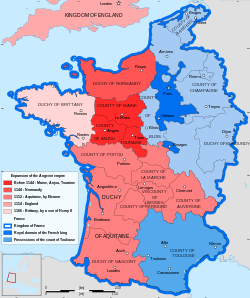You can help expand this article with text translated from the corresponding article in French. (November 2022) Click [show] for important translation instructions.
|
County of Champagne
| |||||||||||
|---|---|---|---|---|---|---|---|---|---|---|---|
| 690–1314 | |||||||||||
 France in 1154 | |||||||||||
| Status | Vassal state of Kingdom of France | ||||||||||
| Religion | Roman Catholicism | ||||||||||
| Government | Feudal County | ||||||||||
| Count of Champagne | |||||||||||
• 690-707 | Drogo | ||||||||||
• 1305-1314 | Louis X | ||||||||||
| Historical era | Middle Ages | ||||||||||
• Established | 690 | ||||||||||
• County merged with the French Crown | 1314 | ||||||||||
| |||||||||||
| Today part of | France | ||||||||||
The County of Champagne (Latin: Comitatus Campaniensis; Old French: Conté de Champaigne),[1] or County of Champagne and Brie, was a historic territory and feudal principality in France descended from the early medieval kingdom of Austrasia. The county became part of the crown lands due to the marriage of Queen Joan I of Navarre, who was the countess of Champagne, and King Philip IV of France.[2]
- ^ Dictionnaire topographique de la France. 1871. p. 55.
- ^ Cazelles, Raymond (1958). La société politique et la crise de la royauté sous Philippe de Valois (in French). Paris: Librairie d'Argences.